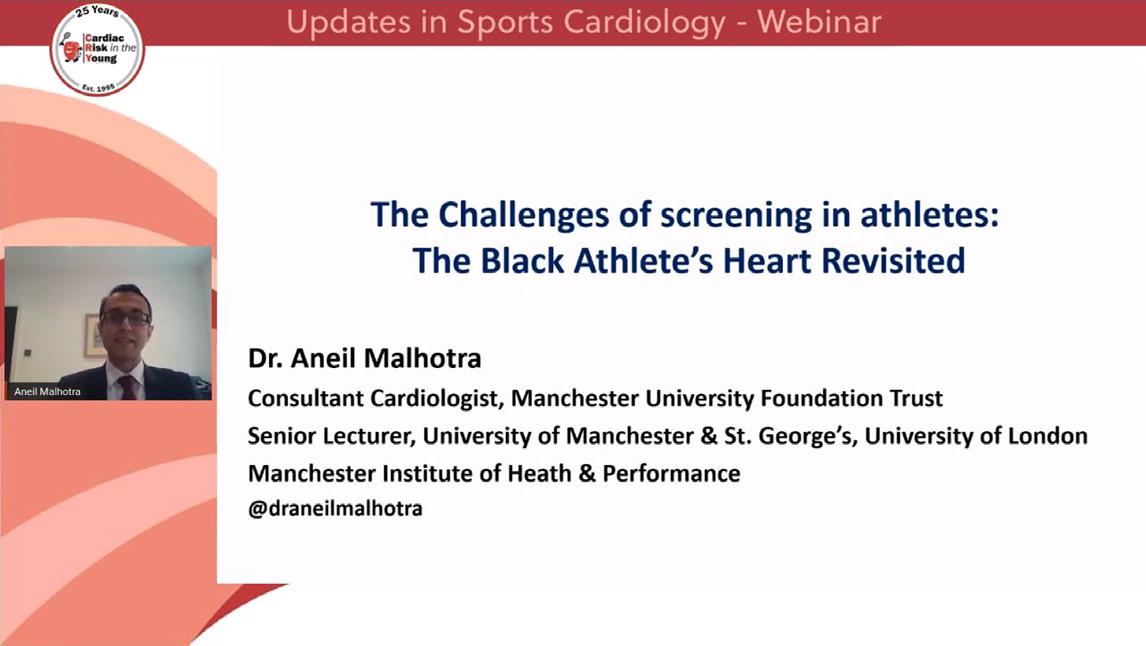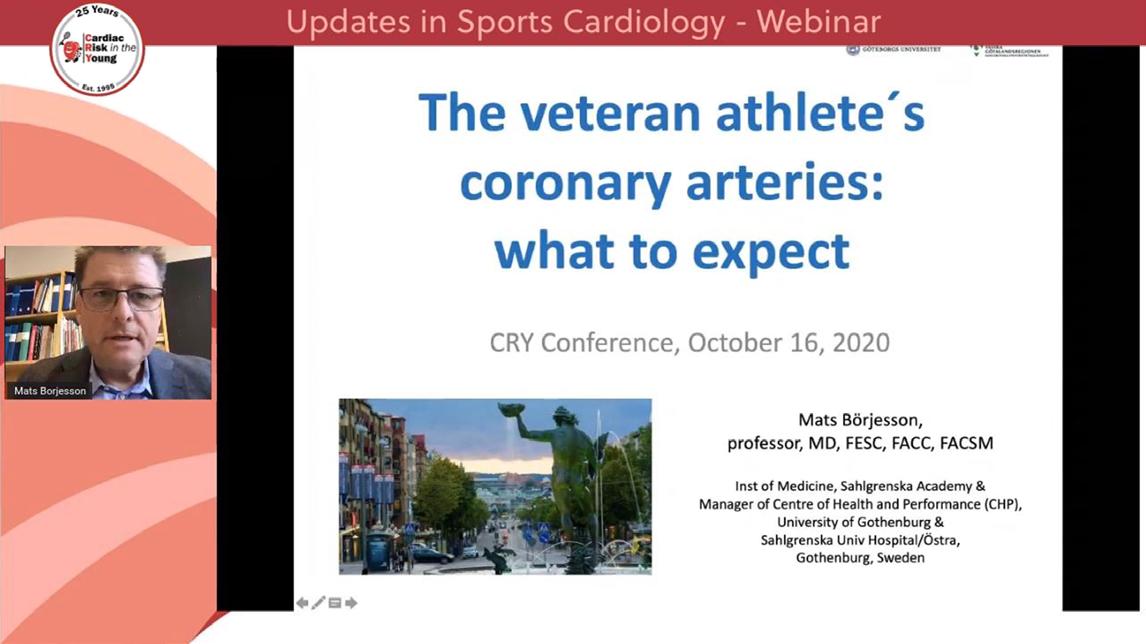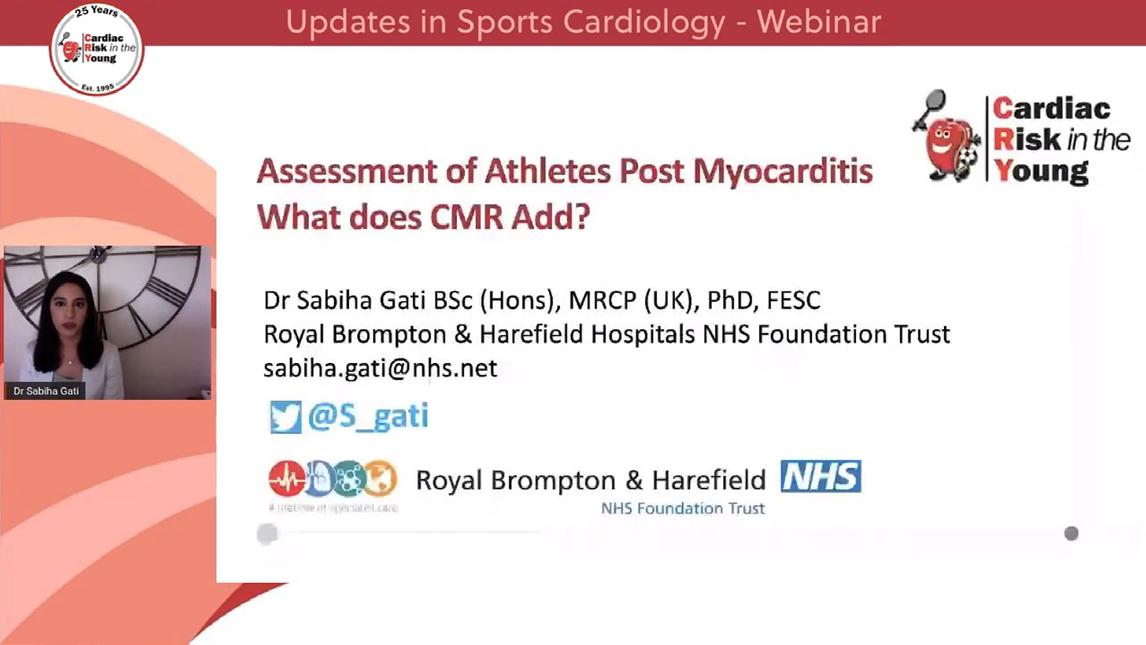
5 minute read
CRY's 2020 virtual International Medical Conference
Similarly to the rest of CRY’s events and fundraising during 2020 due to the COVID-19 pandemic, the CRY Conference had to move online, with presentations being broadcast live through the day. For the first time, on October 16, our annual conference was a virtual event, which offered delegates the opportunity to sign up to watch talks from some of the world’s leading experts in sports cardiology and young sudden cardiac death. While this was rather different from our typical annual conference in London, we still had a fantastic day of talks, with those watching getting involved during presentations by taking part in polls and answering questions, too.
As always, we were pleased to share the insight and research of many leading experts, including some of CRY’s present and past Research Fellows. CRY Consultant Cardiologist Professor Sanjay Sharma began the day with his presentation, “Athlete’s heart or dilated cardiomyopathy; The role of exercise imaging”. Professor Sharma discussed methods of differentiating physiological increases in heart size from dilated cardiomyopathy (DCM). As he pointed out to begin his talk, there is a lot of data about how this is done when dealing with hypertrophic cardiomyopathy and arrhythmogenic right ventricular cardiomyopathy, but there is little data covering DCM. Professor Sharma looked at this topic in extensive detail, and discussed the value of using stress echocardiography due to its better diagnostic ability.
Professor Thijs Eijsvogels from Nijmegen, Netherlands, who is an associate professor at the Radboud University medical centre, gave the second presentation of the day. Professor Eijsvogels looked closely at troponin release following endurance exercise in athletes and what it means. He discussed how exercise-induced increases in troponin are very common following endurance exercise even though the degree of increase can vary significantly depending on the individual, as well as some findings that require more research.
Next, former CRY Research Fellow Dr Aneil Malhotra talked about the challenges of screening in athletes, focusing on the black athlete’s heart. As Dr Malhotra noted at the beginning of his presentation, T-Wave inversion affects one in 30 young athletes and is six times more common in black athletes. T-Wave inversion is present in cardiomyopathy, which increases the risk of exercise-induced sudden cardiac death threefold.

Furthermore, as CRY research has shown, young sudden cardiac deaths are six times more common in young black footballers. This disparity is a problem, and Dr Malhotra went on to look at other conditions and research, as well as what studies need to be completed to help us truly understand the long-term implications of electrical and structural differences in the hearts of black, white and mixed race athletes.
The next presentation of the day came from Professor Domenico Corrado, who has frequently spoken at the CRY Conference for many years now. Professor Corrado gave a talk entitled “Ventricular Ectopy in Athletes Made Simple” and focused on how to interpret different conditions and examine the risks involved for athletes. He concluded that the risk stratification of athletes with ventricular arrhythmias has evolved to the current perspective that prognosis is related to the morphology, complexity and response to exercise, rather than to the number of premature ventricular beats. Uncommon ventricular arrhythmia morphology (mostly right bundle branch block/superior axis) and worsening with exercise could be associated with concealed myocardial fibrosis.
Professor Mats Börjesson’s presentation, “The veteran athlete’s coronary arteries: What to expect,” followed. Professor Börjesson first defined what a veteran athlete is, explaining that they are typically over 50 years of age and take part in competitive sports (mainly endurance events). Regular physical activity has plenty of health benefits, but the problem is that high intensity activity can also be associated with an increased risk for those with an underlying cardiovascular condition.

Professor Börjesson explained that you can expect the presence of subclinical coronary artery disease in veteran athletes, which means that risk evaluation should be completed for all veteran athletes to look at their level of exercise and sports participation. For veteran athletes who are known to have coronary artery disease, an anatomical and functional evaluation should be completed before they participate in high-intensity sports.
Former CRY Research Fellow Dr Sabiha Gati spoke as well, and discussed “The assessment of athletes post myocarditis. What does CMR add?” Dr Gati discussed the subject in plenty of detail, covering everything from the natural history of myocarditis, to the role of cardiovascular magnetic resonance imaging (CMR) is used in both the diagnosis and determining prognosis in myocarditis.

The precise incidence and prevalence of myocarditis is unknown. However, we do know that it accounts for 5-15% of all sudden cardiac deaths in young athletes and 20% of sudden deaths in military recruits, which, as Dr Gati noted, suggests that exercise is an important trigger in myocarditis. Dr Gati went on to discuss methods that can be used to diagnose myocarditis, and concluded that CMR is the most effective non diagnostic method of diagnosis acute myocarditis.
Dr Michael Papadakis gave the final presentation of the day, “COVID-19 and the athlete’s heart.” Dr Papadakis tackled this important subject, and outlined the effects of COVID on the heart, advice for exercising during the COVID-19 era, and provided the rationale for who should have cardiac investigations.

Dr Papadakis began by discussing symptoms of COVID and how different individuals can be affected, including potential impacts on the heart (for example, research showed that up to 30% of those admitted to hospital have elevated troponin, which usually indicates more severe disease). After covering the benefits of exercise, advice and how to return to exercise after testing positive for COVID-19, he laid out a detailed framework for completing cardiac investigations for different individuals.
We are grateful to everyone who followed the conference on the day, and to all of our speakers for giving such fantastic presentations on a range of topics.
To watch all the presentations from this conference, and find out more about CRY's latest research developments, you can read the 2020 issue of CRY's Research Highlights here: https://issuu.com/cardiacriskintheyoung/docs/cry_research_highlights_2020.
For videos of all the presentations from CRY’s International Medical Conferences, sponsored by Radcliffe Cardiology, visit www.c-r-y.org.uk/cryinternational-conference.


